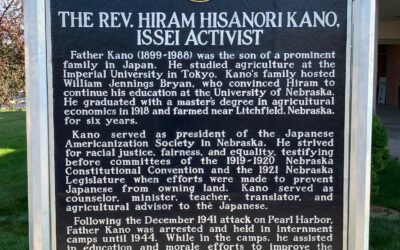The American cowboy has come to symbolize bravery, justice, and the nostalgic freedom of the Wild West. But real cowboys didn’t spend all their time fighting bandits and riding into the sunset like movie heroes. What did real Nebraska cowboys do every day? Find out through a new exhibit at the Nebraska History Museum and an article in the Fall 2013 issue of Nebraska History.
A chuck wagon display is part of Nebraska Cowboys: Lives, Legends, & Legacies at the Nebraska History Museum. The museum is at 15th and P streets in downtown Lincoln. Admission is free.
The exhibit displays cowboy life from the 1870s cattle drives up to the present day, and includes artifacts from museums and private collections from all over Nebraska. The article, “‘A Peculiar Set of Men’: Nebraska Cowboys of the Open Range,” provides an in-depth look at the open range era of the 1870s and 1880s. NSHS Senior Research Historian James Potter uses firsthand accounts to separate fact from legend about the life, work, and character of the men of that short-lived but much-mythologized era.
 “Dime Novels” romanticized cowboy life in ways often at odds with the hard, dangerous reality.
“Dime Novels” romanticized cowboy life in ways often at odds with the hard, dangerous reality.
NSHS RG1345AM-11
After the Civil War, the demand for beef increased greatly and beef suppliers had to find the most efficient way to distribute cattle. Texas ranchers hired cowboys to round up the cattle, then herd them north on the long trail drives to the railroads in Kansas and Nebraska. Potter describes the tough day-to-day living of a cowboy on the trail, as well as the unavoidable dangers. Cowboys could be killed or seriously injured in accidents with horses, cattle, or firearms. Some men were frozen in blizzards. Conflict with Native Americans wasn’t as common as in the movies, but it did happen now and then.
Cowboys had to be both brave and careful on the open range. A June 1876 article described it this way: “No horsemanship can excel that which is displayed by an experienced cow-boy. As they dash over the rough prairie at the top of their mustang’s speed, [dodging] great numbers of holes, the work of prairie dogs and our family of sub-soilers, the utter disregard of their peril is something as courageous as it is rash…No matter what distance the cutting horse has traveled, how fatigued it may be, the moment you ride it into the herd every muscle, every faculty, is on the alert…”
 James H. Cook. His Agate Springs Ranch in the Nebraska Panhandle is now home to Agate Fossil Beds National Monument. NSHS RG3484-1
James H. Cook. His Agate Springs Ranch in the Nebraska Panhandle is now home to Agate Fossil Beds National Monument. NSHS RG3484-1
Cowboys were neither righteous heroes nor “reckless semi-savages,” although many of these young men certainly had a wild side. When arriving in a town after long weeks on the trail, cowboys sometimes got into trouble in the ways they spent their money and free time. One newspaper article described a shootout between the deputy sheriff and two cowboys who resisted arrest for “promiscuous shooting.”
However, newspaper reporters and townspeople only saw the cowboys when they were in town, and didn’t see their hard work along the way. While cowboy and rancher Bartlett Richards admitted his companions’ faults, he considered them “the most generous, kind-hearted men that ever lived would give you their last cent and do any favor for you in their power.”
The magazine is available through the NSHS Landmark Stores. Be sure to pick up a copy when you come to see the exhibit!
– Joy Carey, Editorial Assistant



